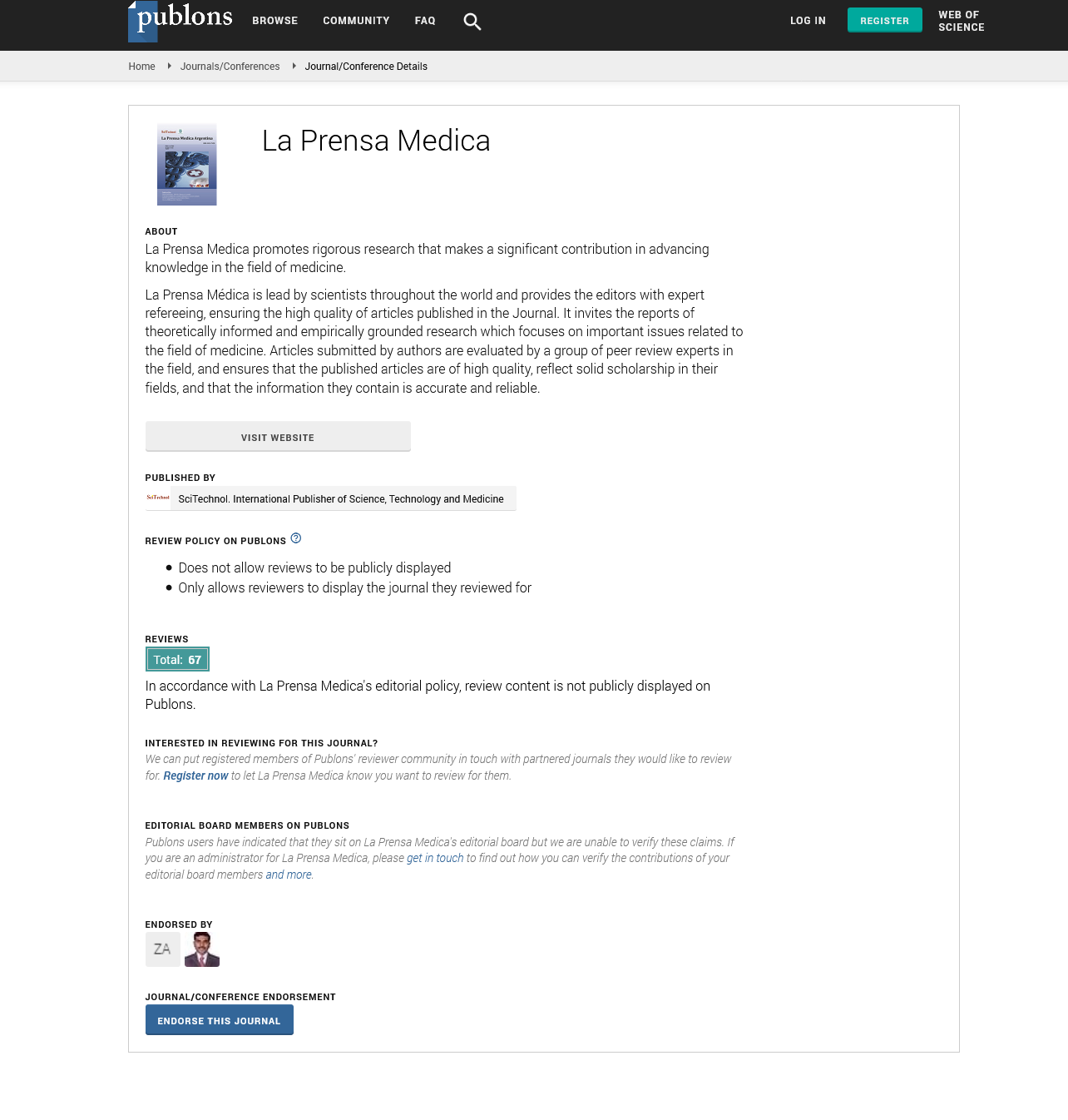Commentary, La Prensa Medica Vol: 108 Issue: 5
The Andrology Medical Surgical Training Programs for Urology
Jennifer Jimenez*
Department of Immunology, Faculty of Health Sciences, University of the Witwatersrand, Johannesburg, South Africa
*Corresponding Author: Jennifer Jimenez, Department of Immunology, Faculty of Health Sciences, University of the Witwatersrand, Johannesburg, South Africa, E-Mail: Jimenez897@gmail.com
Received date: 12 April, 2022; Manuscript No. LPMA-22-64918;
Editor assigned date: 14 April, 2022; PreQC No. LPMA-22-64918 (PQ);
Reviewed date: 25 April, 2022; QC No. LPMA-22-64918;
Revised date: 05 May, 2022; Manuscript No. LPMA-22-64918 (R);
Published date: 13 May, 2022; DOI: 10.4172/0032-745X.1000145
Citation: Jimenez J (2022) The Andrology Medical Surgical Training Programs for Urology. La Prensa Medica 108:5.
Keywords: Celiac Disease, Adalimumab
Description
Celiac Disease (CD) is a continuous immune system substance introduced in hereditarily inclined individuals while devouring glutencontaining prolamins or their constituents. Its commonness is constantly rising, influencing around 1%–2% of the Western populaces. Geo-epidemiological, HLA-DQ2/8 overall genotypes dissemination, co-confined higher wheat and lower rice utilizations are connected with its expansion pervasiveness, in this manner, bear witness to for a natural hereditary exchange in CD turn of events. Truth is told clinically serologically and obsessively, CD contains a few subtypes, traversing potential, idle and traditional CDs. The illness is regularly under analyzed. The analysed proportion is 1/7, separately. Enolase is a glycolytic catalyst, which can be introduced in 3 variations: alpha-enolase, beta-enolase and gamma-enolase. Each isoform is communicated by various quality and their tissue conveyances are interesting: Alpha-enolase is universal, beta-enolase is muscle-explicit and gamma-enolase is neuron-explicit. The declaration of NSE is a helpful list of neural development since it very late appearance during neural separation.
The relationship test was performed utilizing the Pearson connection test assuming the information conveyance was typical, while the Spearman relationship test was utilized on the off chance that the information dispersion was not normal. Across 72 examples, the mean weight file (BMI) was 22.5 kg/m2 and, the mean clinical beginning was 28.02 months. Relationship tests showed a connection between glycine levels and clinical beginning (p=0.026). The ANOVA test showed a contrast between glycine levels with age bunch (p=0.025) and BMI (p=0.015). The relationship between glycine levels and clinical-grade (p=0.416) was not genuinely huge. A hernia is a condition that is set off by both endogenous and exogenous elements. Expanded collagen debasement is likewise connected with the arrangement of a hernia. The arrangement of collagen seems to influence changes in fascial and fundamental tissues. Changes in collagen are likewise seen in patients with hernial repeat; the amino acids that make up the principle part of collagen are glycine, hydroxyproline, proline and alanine. Concerning the BMI information of the hernia patients, we observed that the most reduced BMI was 18.7 kg/m2 and the most noteworthy BMI was 27.6 kg/m2. There is a critical connection between glycine levels and age, BMI, and the clinical beginning of roundabout inguinal hernia. Notwithstanding, there is no connection between glycine levels and the clinical grade of roundabout inguinal hernia.
Expanded Collagen Debasement
In addition, it can go about as a biochemical marker for cancers started from those cells. A precise writing search investigating articles distributed in PubMed, MEDLINE, LILACS and Scielo dating from October, was performed. The inquiry terms were enolase and sensory system disabilities enolase and celiac sickness against enolase antibodies and celiac infection celiac illness and mental manifestations and celiac illness and sensory system. Altogether, 43 articles were remembered for the current survey, all evaded to psycho-neurological signs of CD, the job of enolase and against enolase antibodies in CD just as its job in psycho-neurological-conduct indications of CD. Neuron-explicit enolase and CD were first referenced in. Biopsy examples from patients with CD, Crohn's infection, carcinoma of the duodenum and typical controls were investigated for NSE. An expanded staining of NSE in the mucosa in CD and Crohn's infection was shown. It was the initial occasion when expanded nerve fibers were accounted for in the mucosa in CD and Crohn's infection. NSE staining was more observable in CD than in Crohn's illness. In a gathering of researchers from Czech Republic examined the sera and digestive biopsy examples of patients with CD. Eleven proteins were identified by a proteomic examination among them were Adenosine Tri Phosphate (ATP) synthase chain and two variations of enlace, depicted without precedent for CD patients. The creators referred to an Italian review depicting a cytosolic type of alpha-enlace, yet additionally the layer variation of this compound perceived via autoantibodies. Accordingly, another antigen was found and a clever conceivable instrument of pathogenesis of CD was proposed. Intriguingly, a low titer of AAE IgA and a much raised AAE IgG were recognized in CD sera. This recommends that the actuation of auto reactive B cells against ENO1 could be a foundational occasion and in addition to a nearby, mucosal one. The review exhibited that CD patients had higher titers of AAE, contrasted and the solid subjects. Simultaneously, non-holding fast to Gluten Free Eating regimen (GFD) CD patients had higher titers of AAE Ab contrasted with the agreeable subjects. The creators recommended that those antibodies may be a novel biomarker for intestinal persistent aggravation among resistant CD patients. The arrangement of collagen seems to influence changes in facial and fundamental tissues. Changes in collagen are likewise seen in patients with hernia repeat; the amino acids that make up the principle part of collagen are glycine, hydroxyproline, praline, and alanine. The use of TNF-α inhibitors to treat these patients could be another risk factor for the development of HS. A recent small case series has described HS as a paradoxical reaction after administration of biologics for other reasons, such as IBD, inflammatory rheumatism, and psoriasis. Adalimumab was the most frequently associated biologic, followed by infliximab, and CD was the most common underlying inflammatory disease. The specific treatment for HS did not change, but complete remission was more frequently achieved when the biologic agent was interrupted or switched.
 Spanish
Spanish  Chinese
Chinese  Russian
Russian  German
German  French
French  Japanese
Japanese  Portuguese
Portuguese  Hindi
Hindi 

